Shinzo Abe: The leader who advocated closer India-Japan ties
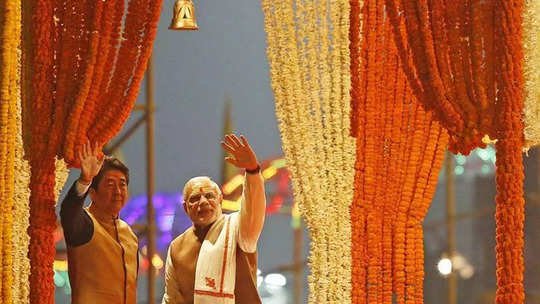

A strong pillar of India-Japan relations collapsed with the departure of Shinzo Abe. Abe, who visited India four times as the Prime Minister of Japan, received a lot of love here. The ‘legacy’ he had been tasked to preserve, Abe made it closer. Be it attending the Ganga Aarti at the ghats of Varanasi or showing Prime Minister Narendra Modi a glimpse of India’s future in a bullet train, Abe has been the face that Indians looked forward to. He was one of those rare leaders who not only made Japan an economic superpower, but also tackled the challenges of the Indo-Pacific region. When Shinzo Abe returned to power in 2012, the slogan was ‘Japan is Back’.
Abe’s vision is clearly visible in geopolitics today. QUAD was conceptualized by Abe while addressing the Indian Parliament in 2007. He was one of the few Japanese leaders to recognize China’s devious motive behind the ‘Belt and Road’ initiative. Abe’s relationship with India was not limited to politics. He had come to India as the PM of his maternal grandfather and had formed a special relationship in his childhood. For this relationship and in honor of Shinzo Abe, India is observing national mourning on 9 July.
Shinzo Abe had an old relationship with India
Shinzo Abe had an old relationship with India, grandfather was a friend of Nehru, Abe and Modi also had a deep friendship.
When Shinzo Abe came to India for the first time as Prime Minister

Shinzo Abe visited India in his first term as the Prime Minister of Japan. At that time there was the UPA government and Manmohan Singh as the Prime Minister. His address to the Indian Parliament on 22 August is known as the ‘meeting of two seas’. In this speech, Abe advocated a free and open Indo-Pacific region. In the next few days, Japan started investing in Northeast India. Japan was the first country to do so. Abe understood that he would not find a better partner than India to deal with the formidable challenge of China.
India-Japan came very close as Abe’s PM
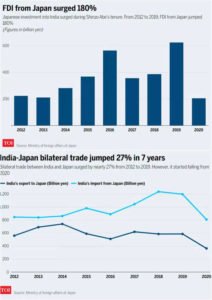
In 2006, Shinzo Abe and Manmohan Singh signed the ‘Strategy and Global Partnership’ between India and Japan. This was the first step towards further strengthening of India-Japan relations. When Abe came to India the next year, there were two more partnerships.
In 2014, the relationship between India and Japan was given ‘special’ status. From investment to economic infrastructure, development, civil nuclear technology to defense, the two countries could walk shoulder to shoulder.
Economic relations between India and Japan improved tremendously under Abe as prime minister. Between 2012 and 2019, foreign direct investment (FDI) from Japan into India increased by 180%.In 2020, the financial aid to India from Japan in the form of loans was 356.30 billion yen. In addition, there is a grant of 5.02 billion yen and technical support of 8.7 billion yen.
Chief Guest of Republic Day Parade in 2014
Japan’s Prime Minister Shinzo Abe was the chief guest of India’s 65th Republic Day celebrations in 2014. He was the first Japanese President to make an appearance on this special occasion. Meanwhile, India invited Japan to participate in the next Indo-US naval exercise. Eight agreements were signed during Abe’s visit.
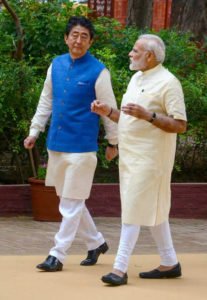
In 2015, Shinzo Abe performed the aarti of mother Ganga.
During his 2015 visit, PM Modi took his Japanese counterpart Shinzo Abe to the ghats of Varanasi. Abe witnessed the famous Ganga Aarti at Dashashwamedh Ghat.
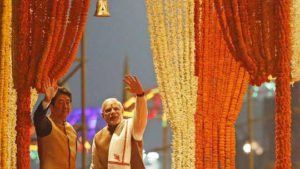
When he came in 2017 he went by giving the gift of a bullet train.
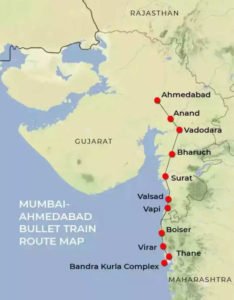
Shinzo Abe’s last visit to India as Prime Minister was in 2017. Then he went to Modi’s home state Gujarat where the foundation stone of the Mumbai-Ahmedabad bullet train project was laid. It is a joint venture between Indian Railways and Shinkasen Technology of Japan. Bullet train is expected to run in India by 2026. Launching this project, Shinzo Abe gave the slogan ‘ Jai Japan, Jai India ‘.
India honored Shinzo Abe with Padma Vibhushan
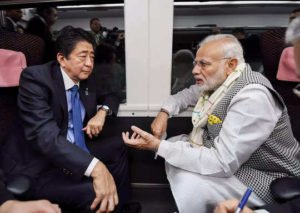
In 2021, he was awarded the Padma Vibhushan by Shinzo Abe in recognition of his contribution to the betterment of Japan’s relations with India. It is the second highest civilian award of India.
DISCLAIMER: The author is solely responsible for the views expressed in this article. The author carries the responsibility for citing and/or licensing of images utilized within the text.
